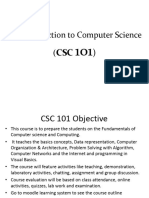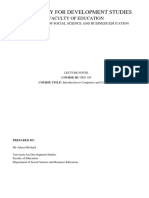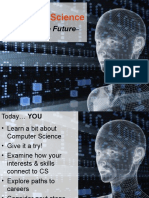0% found this document useful (0 votes)
55 views25 pagesCh1 (Intro)
The document outlines the introductory lecture for a Computer Science course led by Abed EL Safadi, covering administrative details, course objectives, and the importance of studying computer science. Key topics include basic computing concepts, the significance of computing in various fields, and potential career paths in the industry. The lecture emphasizes the transformative role of computing in modern society and encourages students to engage with the material actively.
Uploaded by
jimimjimin13Copyright
© © All Rights Reserved
We take content rights seriously. If you suspect this is your content, claim it here.
Available Formats
Download as PDF, TXT or read online on Scribd
0% found this document useful (0 votes)
55 views25 pagesCh1 (Intro)
The document outlines the introductory lecture for a Computer Science course led by Abed EL Safadi, covering administrative details, course objectives, and the importance of studying computer science. Key topics include basic computing concepts, the significance of computing in various fields, and potential career paths in the industry. The lecture emphasizes the transformative role of computing in modern society and encourages students to engage with the material actively.
Uploaded by
jimimjimin13Copyright
© © All Rights Reserved
We take content rights seriously. If you suspect this is your content, claim it here.
Available Formats
Download as PDF, TXT or read online on Scribd
/ 25






















































































